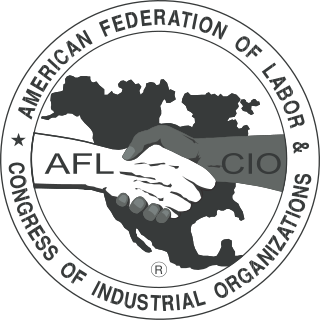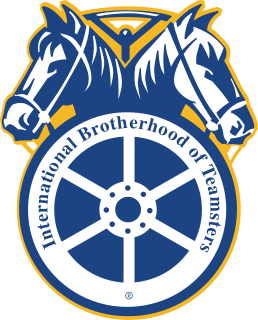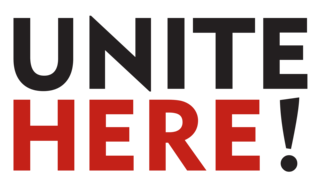
The American Federation of Labor and Congress of Industrial Organizations (AFL–CIO) is the largest federation of unions in the United States. It is made up of 56 national and international unions, together representing more than 12 million active and retired workers. The AFL–CIO engages in substantial political spending and activism, typically in support of liberal or progressive policies.

John Llewellyn Lewis was an American leader of organized labor who served as president of the United Mine Workers of America (UMW) from 1920 to 1960. A major player in the history of coal mining, he was the driving force behind the founding of the Congress of Industrial Organizations (CIO), which established the United Steel Workers of America and helped organize millions of other industrial workers in the 1930s, during the Great Depression. After resigning as head of the CIO in 1941, Lewis took the United Mine Workers out of the CIO in 1942 and in 1944 took the union into the American Federation of Labor (AFL).

The International Union, United Automobile, Aerospace, and Agricultural Implement Workers of America, better known as the United Auto Workers (UAW), is an American labor union that represents workers in the United States and Canada. It was founded as part of the Congress of Industrial Organizations (CIO) in the 1930s and grew rapidly from 1936 to the 1950s. The union played a major role in the liberal wing of the Democratic Party under the leadership of Walter Reuther. It was known for gaining high wages and pensions for auto workers, but it was unable to unionize auto plants built by foreign-based car makers in the South after the 1970s, and it went into a steady decline in membership; reasons for this included increased automation, decreased use of labor, movements of manufacturing, and increased globalization.

The International Brotherhood of Teamsters (IBT), also known as the Teamsters Union, is a labor union in the United States and Canada. Formed in 1903 by the merger of The Team Drivers International Union and The Teamsters National Union, the union now represents a diverse membership of blue-collar and professional workers in both the public and private sectors. The union has approximately 1.3 million members as of 2015. Formerly known as the International Brotherhood of Teamsters, Chauffeurs, Warehousemen and Helpers of America, the IBT is a member of the Strategic Organizing Center and Canadian Labour Congress.

The American Federation of Labor (AFL) was a national federation of labor unions in the United States founded in Columbus, Ohio, in December 1886 by an alliance of craft unions disaffected from the Knights of Labor, a national labor union. Samuel Gompers was elected the full-time president at its founding convention and reelected every year, except one, until his death in 1924. He became the major spokesperson for the union movement.
The United Food and Commercial Workers International Union (UFCW) is a labor union representing approximately 1.3 million workers in the United States and Canada in industries including retail; meatpacking, food processing and manufacturing; hospitality; agriculture; cannabis; chemical trades; security; textile, and health care. UFCW is affiliated with the Canadian Labour Congress (CLC) and the AFL–CIO; it disaffiliated from the AFL–CIO in 2005 but reaffiliated in 2013. UFCW is also affiliated to UNI Global Union and the IUF.

The labor history of the United States describes the history of organized labor, US labor law, and more general history of working people, in the United States. Beginning in the 1930s, unions became important allies of the Democratic Party.

Service Employees International Union (SEIU) is a labor union representing almost 1.9 million workers in over 100 occupations in the United States and Canada. SEIU is focused on organizing workers in three sectors: healthcare, including hospital, home care and nursing home workers; public services ; and property services.

John Joseph Sweeney was an American labor leader who served as president of the AFL–CIO from 1995 to 2009.

Sidney Hillman was an American labor leader. He was the head of the Amalgamated Clothing Workers of America and was a key figure in the founding of the Congress of Industrial Organizations and in marshaling labor's support for Franklin Delano Roosevelt and the Democratic Party.

UNITE HERE is a labor union in the United States and Canada with roughly 300,000 active members. The union's members work predominantly in the hotel, food service, laundry, warehouse, and casino gaming industries. The union was formed in 2004 by the merger of Union of Needletrades, Industrial, and Textile Employees (UNITE) and Hotel Employees and Restaurant Employees Union (HERE).
Amalgamated Clothing Workers of America (ACWA) was a United States labor union known for its support for "social unionism" and progressive political causes. Led by Sidney Hillman for its first thirty years, it helped found the Congress of Industrial Organizations. It merged with the Textile Workers Union of America (TWUA) in 1976 to form the Amalgamated Clothing and Textile Workers Union (ACTWU), which merged with the International Ladies' Garment Workers' Union in 1995 to create the Union of Needletrades, Industrial and Textile Employees (UNITE). UNITE merged in 2004 with the Hotel Employees and Restaurant Employees Union (HERE) in 2004 to create a new union known as UNITE HERE. After a bitter internal dispute in 2009, the majority of the UNITE side of the union, along with some of the disgruntled HERE locals left UNITE HERE, and formed a new union named Workers United, led by former UNITE president Bruce Raynor.

Lee Pressman was a labor attorney and earlier a US government functionary, publicly alleged in 1948 to have been a spy for Soviet intelligence during the mid-1930s, following his recent departure from Congress of Industrial Organizations (CIO) as a result of its purge of Communist Party members and fellow travelers. From 1936 to 1948, he represented the CIO and member unions in landmark collective bargaining deals with major corporations including General Motors and U.S. Steel. According to journalist Murray Kempton, anti-communists referred to him as "Comrade Big."

Labor unions in the United States are organizations that represent workers in many industries recognized under US labor law since the 1935 enactment of the National Labor Relations Act. Their activity today centers on collective bargaining over wages, benefits, and working conditions for their membership, and on representing their members in disputes with management over violations of contract provisions. Larger trade unions also typically engage in lobbying activities and electioneering at the state and federal level.

David Daniel Beck was an American labor leader, and president of the International Brotherhood of Teamsters from 1952 to 1957. He helped found the "Conference" system of organization in the Teamsters union, and shot to national prominence in 1957 by repeatedly invoking his right against self-incrimination before a United States Senate committee investigating labor racketeering.
Graduate student employee unionization, or academic student employee unionization, refers to labor unions that represent students who are employed by their college or university to teach classes, conduct research and perform clerical duties. As of 2014, there are at least 33 US graduate employee unions, 18 unrecognized unions in the United States, and 23 graduate employee unions in Canada. By 2019, it is estimated that there were 83,050 unionized student employees in certified bargaining units in the United States. Almost all US graduate employee unions are located in public universities, most of which formed during the 1990s. In 2014, New York University's Graduate Student Organizing Committee, affiliated with the United Automobile Workers (UAW), became the first graduate employee union recognized by a private university in the US. In September 2018, Brandeis University became the second private university to negotiate a collective bargaining agreement for graduate student employees, followed by Tufts University in October 2018 and Harvard in July 2020. American University and New School were in the process of negotiating an agreement as of September 2018. Many of these unions refer to their workers as Academic Student Employees (ASEs) to reflect the fact that their membership may also include undergraduate students working in represented job classifications. In 2019, the National Labor Relations Board (NLRB) proposed a new rule that said graduate students are not employees, which could affect unionization efforts at private universities, although the final rule has yet to be published.

The American Federation of State, County and Municipal Employees (AFSCME) is the largest trade union of public employees in the United States. It represents 1.3 million public sector employees and retirees, including health care workers, corrections officers, sanitation workers, police officers, firefighters, and childcare providers. Founded in Madison, Wisconsin, in 1932, AFSCME is part of the AFL–CIO, one of the two main labor federations in the United States. AFSCME has had four presidents since its founding.
A paper local is a local union with no or few members, chartered by an existing union or self-chartered, and formed for the purpose of criminal activity. As implied by the name, paper locals often "exist only on paper", and have no members. In some cases, however, paper locals may have members, but the members are not workers but rather friends, family members, or criminal associates of the individual or individuals in control of the paper local.
The Martin Luther King. Jr. County Labor Council, AFL–CIO, (MLKCLC) is the central body of labor organizations in King County, Washington. The MLKCLC is affiliated with the national AFL–CIO, the central labor organization in the United States, which represents more than 13 million working people. Over 125 organizations are affiliated with the MLKCLC, and more than 75,000 working men and women belong to Council-affiliated organizations. Not only does the MLKCLC support labor organizations, but it acts as a voice for the interests and needs of the working people in King County, WA.

The Congress of Industrial Organizations (CIO) was a federation of unions that organized workers in industrial unions in the United States and Canada from 1935 to 1955. Originally created in 1935 as a committee within the American Federation of Labor (AFL) by John L. Lewis, a member of the United Mine Workers (UMW), and called the Committee for Industrial Organization, its name was changed in 1938 when it broke away from the American Federation of Labor. It also changed names because it was not successful with organizing unskilled workers within the AFL.














